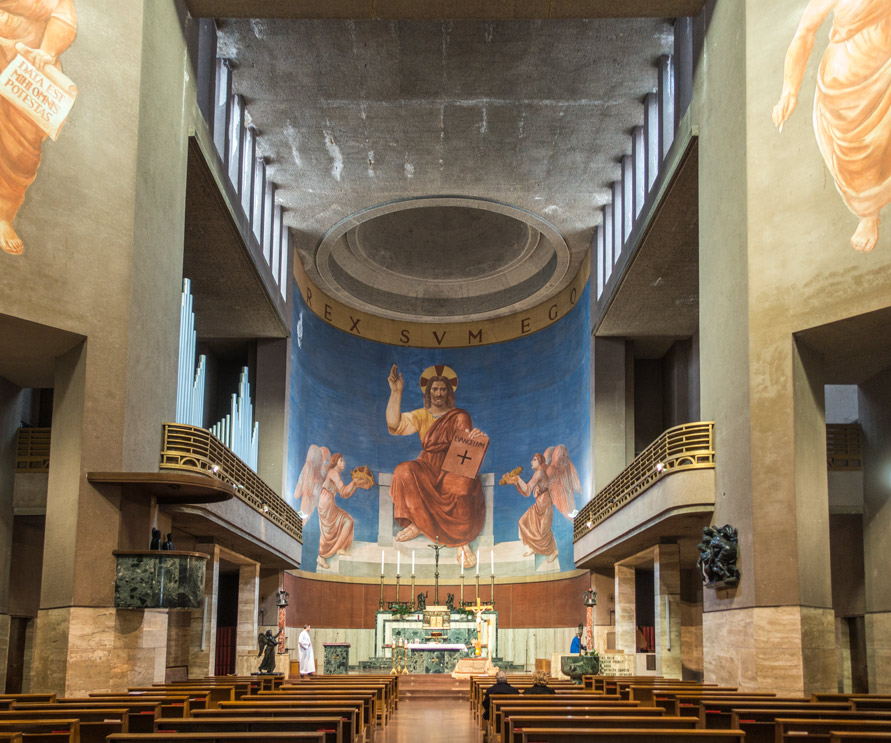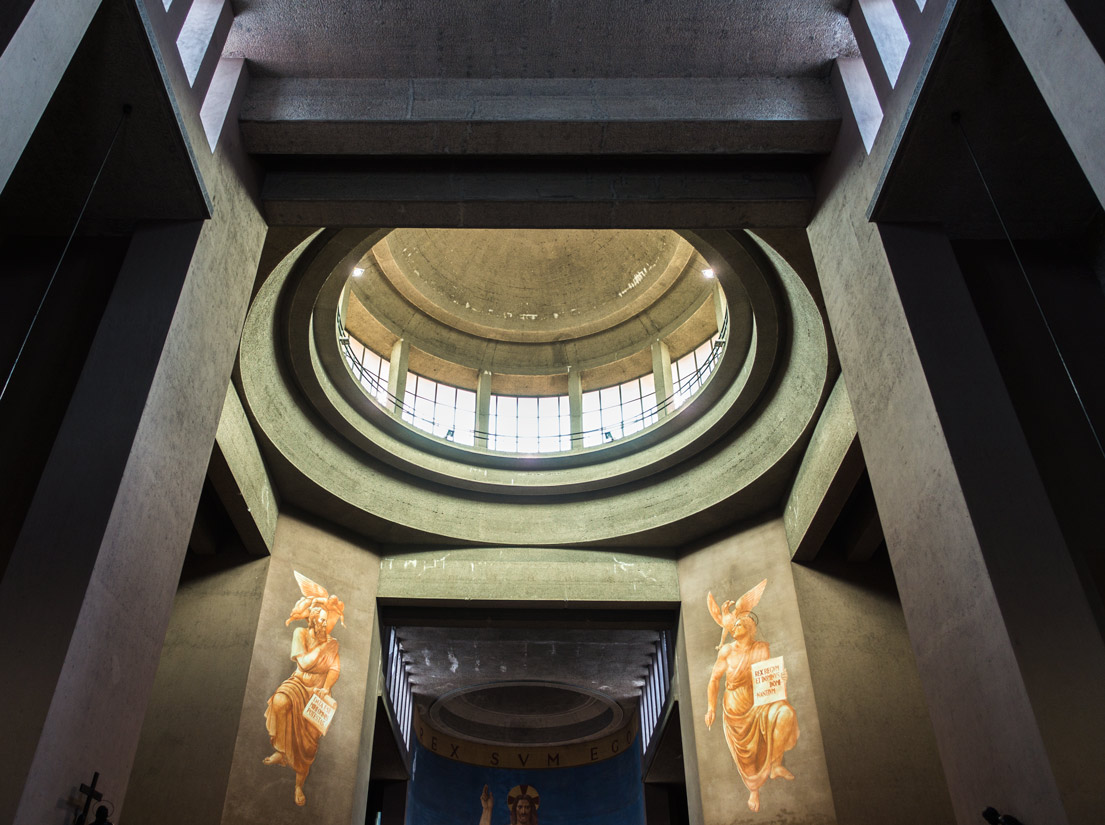
BUDOWLE & OBIEKTY Churches and chapels
Church of Sacro Cuore di Cristo Re, meaning, the beginning of a new era of sacral architecture

The church was seen as a building ushering in a new era in the history of sacral, Italian architecture and this was a view not of the supporters of Fascism, but architecture historians from the 60s of the XX century. What, during the regime of Benito Mussolini was a textbook example of civil engineering in new Italy, became a breakthrough moment for Italian architecture in general. Let us take a look at how it happened. The plans, created by a young architect, Marcello Piacentini, with previous works strongly marked by eclecticism, were already prepared in 1919, while construction started in the following year. The tense, at that time, situation between the pope and the then Italian state, made representatives of the Church turn towards architectural forms of late Renaissance and Baroque. Therefore, the artist presented a design in a style reminiscent of the greatest achievements of Roman architecture of the XVI and XVII centuries, at the same time seeking the tradition recalling the glorious moments of the Roman Catholic Church. However, Piacentini changed his plans and it was not until 1924 when he began his work anew, continuing it all the way up to 1931, when Italian architecture experienced a breakthrough moment. Its creators began searching for a new style – expressing modernity, but rooted in tradition, bereft of the stylistic elements of previous epochs, yet using the full gamma of old forms, consciously “digested”. They were convinced, that Fascist architecture should get rid of imitation, however, at the same time not give up the spirit of the great Roman civilization, Young, looking towards the future Italy, did not shy away from new architectural solutions, presented at that time in Europe and America. Particularly the example coming from Nazi Germany and the modern structures created there, increased the interest of Duce in raw, purist forms. For the Fascist government architecture became a mission, a conscious way of shaping public space in the spirit of modernism – a style which for Mussolini and the artists working for him seemed to best express the new spirit of Fascist Italy. That is why, the stylistic pluralism still typical in the 20s of the XX century, was done away with at the start of the following decade. An educated, intelligent and ambitious Piacentini became the principal creator of the new Italian architecture, the trusted designer of Duce, and at the same time the author of the text Architettura d’oggi (Today’s Architecture, 1930), in which he unambiguously spoke out in favor of modernity. And it was in this spirit, that he changed the concept of his design, because the original one, in face of the historical events taking place and political visions, lost its validity, and simply became anachronistic. More importantly, these types of changes were allowed by the Church itself, which despite “genetic” devotion to tradition, after the signing of the Lateran Accords, and naming Mussolini the providential father of the nation, let itself be convinced, that sacral construction should also be in line with modern form.

In 1934 the new, completely remodeled church was consecrated. It even lost its original dedication – from Church of Peace, which was to commemorate the victims of World War I, it became the Church of Christ the King. This should come as no surprise, as it was difficult to support peace at a moment when preparations for war were in full swing (annexation of Abyssinia). Romans, not accustomed to these types of forms, must have been really surprised by the unusual for their city, perfect example of purist in spirit and monumental in form, architecture created out of straight prisms. The church elevation was covered with raw, placed in rows (receding and protruding) light-colored brick, while the flat façade was flanked with two bell towers, thanks to which it was reminiscent of structures from the Roman period. The only decoration of both the façade and the figure, were travertine fittings of windows and entry openings as well as few in number, heavily simplified bas-reliefs. The monumental, made out of concrete interior, was topped off with a dome, 36 meters in height, with a diameter of 20 meters. However, this is not the only thing that let light inside, as this was also done by a row of windows placed high in the part of the presbytery.
Those who exhibited skepticism towards this architectural creation, were quickly silenced when it was praised by Mussolini himself. In this way the work gave assumption to imitate this kind of construction all over Italy, while Piacentini was assured the role of leader and the status of head architect of Italy.
Therefore, it is worth moving away from the tourist routes to enter this raw space, adorned only with enormous frescoes (Alfredo Biagini, Achille Funi), in order to formulate our own opinion, whether it is indeed just a breakthrough structure, or perhaps the architect can still today convince us of his vision.
Może zainteresuje Cię również
Via della Conciliazione – a road to reconciliation, and at the same time the beginning of a new era for the Church
Zgodnie z art. 13 ust. 1 i ust. 2 rozporządzenia Parlamentu Europejskiego i Rady (UE) 2016/679 z 27 kwietnia 2016 r. w sprawie ochrony osób fizycznych w związku z przetwarzaniem danych osobowych i w sprawie swobodnego przepływu takich danych oraz uchylenia dyrektywy 95/46/WE (RODO), informujemy, że Administratorem Pani/Pana danych osobowych jest firma: Econ-sk GmbH, Billbrookdeich 103, 22113 Hamburg, Niemcy
Przetwarzanie Pani/Pana danych osobowych będzie się odbywać na podstawie art. 6 RODO i w celu marketingowym Administrator powołuje się na prawnie uzasadniony interes, którym jest zbieranie danych statystycznych i analizowanie ruchu na stronie internetowej. Podanie danych osobowych na stronie internetowej http://roma-nonpertutti.com/ jest dobrowolne.